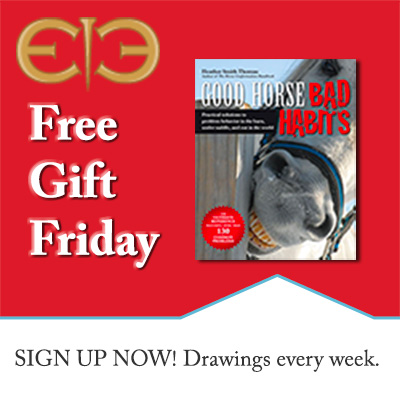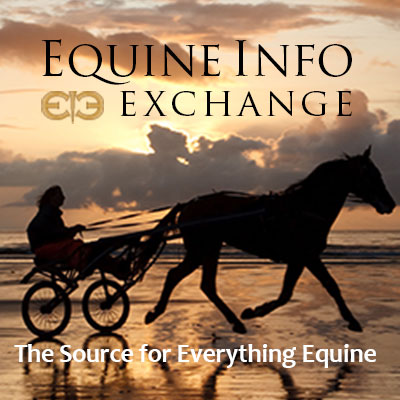Recreation & Lifestyle
Welcome to Recreation & Lifestyle, which includes leisure riding and other aspects of the equestrian lifestyle for you and your horse loving friends and family.
Looking for the perfect present? See the Gifts & Jewelry section. Redecorating? Find a Painting, Photograph or Sculpture in the Artwork section. Need to check out a movie or crawl up with a good book or magazine? See our Entertainment section where you will find and Books, Movies, Games, and Magazines. And don't forget about Fine Art in some specialty Museums that might surprise you.
Looking for love or a trail buddy? Riding Partners is the spot to seek other riders who share your passion. Find a place to ride with that special person in our Trail Riding section and if you need more time away, take a look at Vacations. Want to know about the next horse show or special event? Don’t miss it! Dates and locations are included in the Calendar of Events for Recreation & Lifestyle.
Do we need to add more? Please use the useful feedback link and let us know!
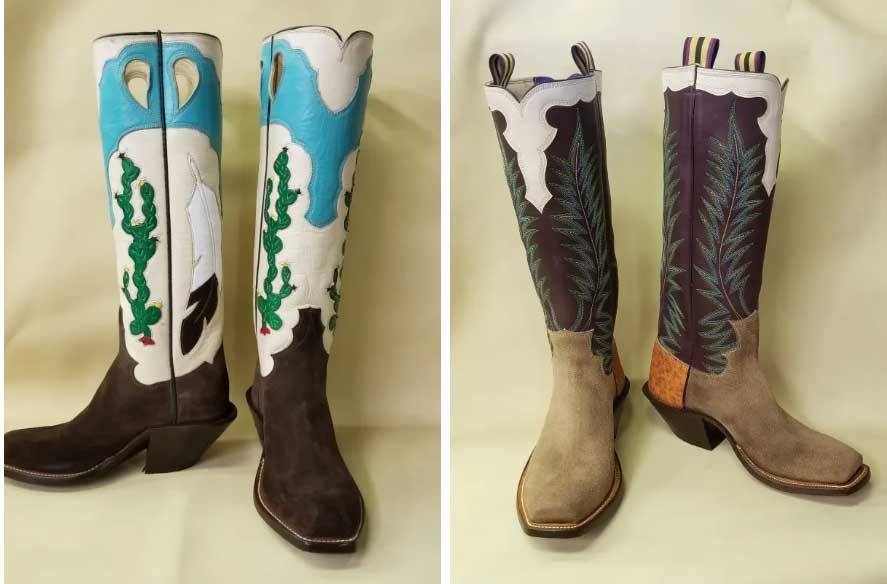
By Nick Pernokas
Tim Bishop was raised in the small, eastern New Mexico town of Logan. Tim’s high school had only 13 in his graduating class. In this rural ranching community, there were only a few choices in lifestyle for a teenager. Tim chose the most attractive one to him which was the western one.
“Everybody wore boots,” Tim remembers fondly.
Tim’s dad retired from the military in Logan and the family lived in town. Tim fell in with some of the ranch kids and was introduced to that lifestyle at a young age. One ranch family in particular, the Keiths, became his lifelong friends. The Keiths had a small saddle shop on their ranch. When Tim wasn’t helping them work cattle, he would be watching Melvin Keith build ranch saddles.
“I’d go stay with them every chance I got,” says Tim.
During high school, Tim day worked on some of the local ranches. Boots were more than a cool piece of wardrobe; they were an important tool of the trade. Tim paid attention to what a lot of the older cowboys wore on their feet. The younger cowboys wore store bought boots like Sanders and Panhandle Slim, but many of the old timers wore custom boots like Blucher and Paul Bond. The mental notes would pay off later. When Tim graduated in 1985, he got a job with the historic Tequesquite Ranch.
As time passed, Tim moved on and cowboyed on several outfits. With time on his hands at night, Tim learned to fix his own saddle and build his own leggings. By 1987, Tim was riding pens in the feed yards at Gruver, Texas. Amarillo was the closest large city to do business in. When Tim got in to Amarillo, he would always stop in Bob Marrs’ saddle shop and soak up the smell and the knowledge that circulated there. Tim also stopped by TSTI in Amarillo, and was inspired by the classes in saddle making that were offered.
Tim ordered his first pair of custom boots from Paul Bond in Nogales, while he was working in Gruver. They were a cowboy fashion statement with 18-inch bright green tops, a black waxed calf vamp with a 2 ¼-inch under slung riding heel and a round toe. He called one day to see how they were coming along. Paul answered the phone and in the course of the conversation, Paul offered Tim a job in his boot shop. Within two weeks, Tim was in Nogales working for Paul and Chris Bennett in the shop.
“It sure did open my eyes.”
Eventually, Tim became homesick for the ranches of northern New Mexico and ended up back on a ranch there. In 1989, Tim went to work for a construction crew that went all over the country burying cable. Later, he returned to New Mexico with his fiancée, Brenda, and took a job with the county.
“I’ve been all over, but I always seem to gravitate back here.”
Tim began building a few saddles in his garage in his free time. Marriage followed in 1990, and Tim started thinking seriously about a job that he would like; one that wouldn’t be so far away from the cowboy life, but a little more stable. In 1992, Tim saw an ad in an equine magazine for the Oklahoma State University Institute of Technology in Oklahoma. A visit to the saddle shop at Okmulgee followed. Tim really liked the instructor, Mike DeWitt, and felt like he could pursue his interests in saddles and cowboy gear there. By just taking the shop classes, Tim was able to cram an almost two-year curriculum into 10 months.
In 1993, Tim opened his own saddle shop in Tucumcari, New Mexico. He took any jobs he could and he made a lot of belts for New Mexico State Police officers. Boat tarp and flip-flop repairs came in from the area lakes. He continued to supplement his income by day working on the ranches outside of town. Tim realized that there were a lot of saddlemakers in the county, but not very many boot repairmen. He decided to move into the boot business.
“It was something I‘d been interested in all of my life.”
In 1994, Tim’s daughter, Bethany, was born and in 1997, the Bishops had a son, Wyatt. Both of Tim’s children frequently worked in the shop. His daughter was good at tearing down repair saddles, but didn’t pursue leatherwork as a career. Wyatt still lends Tim a hand in the shop from time to time, but he’s gone into the bit and spurmaking business under the name of Wyatt Bishop Silver Work.

This is a fascinating bit of history for the West Village in New York city and throughout the buroughs. Click the audio button to hear the story.
@johnnymurtaugh The boot-scraper #history #nyc
♬ original sound - Johnny Murtaugh
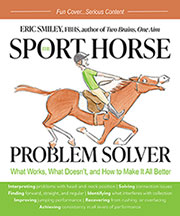
by Eric Smiley
The development of the mind and body, either human or equine, to perform at its optimum goes through many stages before it reaches its peak. Along the way, it encounters mental and physical barriers, which must be overcome if it is to be the best it can be. Some of these challenges improve the resolve to succeed, while others leave scars that impede progress or even threaten the realization of the ultimate goal. How do we keep our horses and our partnership with them on the right track?
Education should be an enlightening experience full of understanding, but the success of all forms of education depends on adhering to a progressive system: one step at a time, layer upon layer of information, you build a solid foundation, progress to the next level, and so on. This applies to both physical and psychological challenges, especially in the early years of development. To move from one stage to the next requires a confidence in where you are and a belief that where you are going is within your capabilities. Without this solid base, progress is uncertain. This is true of humans in their education but is even more true of horses whose education is guided by humans.
How often have we heard of parents entering their children for a competition that is above their level with reasoning such as, “It’ll be good for them,” “They will see what the standard is,” “It will show them what to work on”…only for the child to be knocked out at the first metaphoric hurdle and come home deflated.
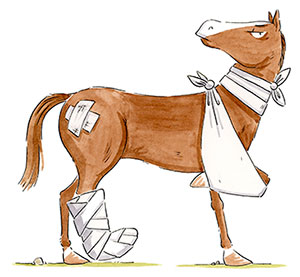
On the way home the parent then says, “Don’t worry, it’ll be better next time.”
But the chances are that it won’t be. A marker of failure and for failure has been put in place and that is very difficult to overcome.
Draw the same analogy with a young horse. Move him up in level to gain experience, only to find that he knocks fences or has run outs. The marker of failure has been laid down. Or he tries so hard to please and jumps clear, but the next time out he remembers the experience as being unpleasant and performs badly. Now that marker of failure has had a confirmation. Bad news.
This is what’s known as overfacing, a term that is defined as: to intimidate, especially by presenting too great a task or obstacle. Although the word is typically associated with asking a horse to jump something beyond his ability, it can be equally useful when applied to other aspects of training, including groundwork and riding on the flat. It’s crucial, in fact, that we embrace this broader understanding so we don’t become the architects of our own problems by pushing a horse too far, too fast. For just one example of the perils of overfacing, consider Thoroughbreds that begin a racing career at age two—those that go on to retire sound in mind and body are in the minority.
Horses are generous animals, constantly curious, and willing to take an interest in most things that are asked of them. Very few are disingenuous, which makes them good students.
The key is to stimulate their interest, understand their limitations, and be cautious not to take advantage of their desire to please. In stimulating their interest we must set achievable goals. This is how we create a pathway to learning: with clear, well-planned steps, direction, and plentiful rewards as we go. With interest and achievement much can be done.
These are the fundamentals of Progressive Training.

A Year-by-Year Breakdown
Ultimately, the goal of any horse’s journey should be for longevity, in his sport or just in his life as a nice riding horse. Horses that are still competing at the highest level when they are well into their teens tend to have been brought up the correct way.
In simple terms:
- A four- to five-year-old is starting.
- A six- to seven-year-old is learning the mechanics and skills of his trade.
- An eight- to nine-year-old is developing and improving these skills.
- A ten- to fourteen-year-old is in his prime.
- Fifteen years old plus is bonus time.
The most critical years are between four and five and then again when a horse is seven. At seven there is a temptation to think of them as mature and adult. But that would be foolish. This time of life is fragile, as horses are beginning to show what they can do (their potential) but are not yet secure, either physically or mentally. To make a mistake in either physical or mental development can leave scars they may never recover from. However, using this time to consolidate experience, skill, and confidence at the appropriate level will allow horses to learn to believe in themselves and the future.
The Sport Horse Problem Solver
BUY NOW on Amazon
Paperback | Kindle
This excerpt from The Sport Horse Problem Solver by Eric Smiley is reprinted with permission from Trafalgar Square Books (HorseandRiderBooks.com).
There are so many great reads in our section on Books.

In a matchup that will go down in boxing history as one of the most significant title fights of all time, unified WBC, WBA and IBF Welterweight World Champion Errol “The Truth’’ Spence Jr. will take on WBO 147-pound world champion Terence “Bud’’ Crawford for the Undisputed Welterweight World Championship on Saturday, July 29 in a highly anticipated SHOWTIME PPV clash from T-Mobile Arena in Las Vegas headlining a Premier Boxing Champions event.
The winner of this battle of undefeated superstars will become the first undisputed welterweight world champion in the four-belt era and likely emerge as the sport’s No. 1 pound-for-pound fighter. But we also know Errol Spence Jr. as a horse lover! Let's look back....
In the early-morning hours of October 10, 2019, the life of Errol Spence Jr., one of the boxing’s brightest pay-per-view stars and undefeated boxing champion changed in a flash.
Driving his $300,000 Ferrari 488 Spider at frighteningly high speeds on the streets of downtown Dallas, Texas, where he resided – he'd been drinking and wasn't wearing his seatbelt -- Spence, then 29, lost control of his car when he hit a median and was ejected through the windshield as the Ferrari cartwheeled multiple times and was totally destroyed. The entire crash was caught on tape by a nearby security camera.
Miraculously, Spence, nicknamed “The Truth,” not only survived but suffered no broken bones and only some facial cuts and the loss of a couple teeth. Just a few weeks removed from successfully defending his welterweight titles, the boxer quickly realized he had cheated death and lived to talk about it.
“I don’t know how or why I got saved, but thank God,” he later wrote on Instagram. “The thought of leaving my (three) little girls and them growing up without me still (messes) with me, but I’m triple blessed and must be here for a reason . . . My accident slowed me down and gave me a different perspective on (things) I was taking for granted.”
Armed with a new lease on life, Spence found that new perspective in a nearly 60-acre ranch he purchased in DeSoto, Texas, just south of Dallas.
“I was just trying to find answers, you know? I needed to go somewhere new and start over and get out of that dark cloud that was downtown,” he said in a recent interview, “and be in a better element, because I’m already like an introvert; I don’t like being around people that much anyway.
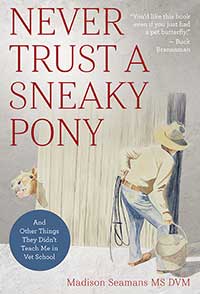
By Madison Seamans MS DVM
When I was a bright, young veterinarian just starting practice back in the eighties, I got a phone call from a man named Bob Gray who lived out of state. He asked me if I was available for a pre-purchase exam on a real good colt that he was thinking about buying. In those early days of my practice, this was like asking my cat if he was available for a can of tuna and a nap! I was so eager to practice medicine, I would have vaccinated his goldfish.
“When would you like me to look at this colt,” I asked while I thumbed through my nearly-empty appointment book. “I’ll try to work you into my schedule.” I took a deep breath and hoped that I had not violated some part of the veterinary oath.
“Any time would be okay with me,” he said. “I won’t be able to be there when you look at him, so just do it when it is convenient for you.” The voice came over the phone like a ray of hope, saving me from having to enroll in the Ace Truck Driving School to keep from starving. “The colt has some great bloodlines, and I am planning on using him as a foundation sire in my breeding program. If you find anything wrong with him, I need to know about it. This is a real expensive horse, and I don’t want any surprises. He’s just a yearling now, but I have a lot of hope for him.” Mr. Gray paused, then repeated: “He has great bloodlines.”
I had no idea that this last phrase would come to haunt me for years.
Bob gave me the name and phone number of the lady who owned the colt in question. I called Carla, and we made an appointment for later in the week. She was friendly enough but let me know clearly that there was nothing wrong with the colt. If Mr. Gray considered a prepurchase exam necessary, that was “all right with her.”
I have never considered myself a distrusting fellow, but I have been involved in enough horse trades over the years to realize their potential to bring out the scariest parts of human nature. In addition, I have purchased enough lame, crazy, crippled and just overall bad horses to become, well, “cautious” when dealing with the buying and selling of horses.
For example, when I was still a student, way back in the early seventies, one of the ways that I supported my college habit was by riding colts for people and trading a few horses myself. One time I bought a big, stout, red, four-year-old gelding that I called Red Man. I rode him for quite a while as he had about every bad habit a horse could have. When I finally sold him, he was about fifteen years old. I didn’t ride him that long, he just wasn’t that young! I took quite a beating physically and economically, as this old snide had crippled a couple of local cowboys before I got him, and he hadn’t seen his fourth birthday since LBJ was president.
Some of life’s best lessons are also its toughest, and I was lucky to have survived that one. It did motivate me to learn how to tell the age of a horse by looking at his teeth, and I got pretty good at it out of economic necessity.
Read more: “He Has Great Bloodlines” - Excerpt from "Never Trust a Sneaky Pony"

When you think of the Kentucky Derby you think of two things: big horses and big hats. Women’s hats. There are plenty of other big racing days, but none of them in the United States are associated with the millinery grandeur the same way as this longest consecutively running sporting event on the first Saturday in May and began in 1872. The first editorial mention of hats at the Derby was in a 1926 edition of Time Magazine. It wasn't much of a mention, and was stuck in the middle of an extremely long, convoluted sentence describing the start of the race. “… hats and parasols and a foam of faces…”
For those of you who are new to the sport, the Kentucky Oaks is run the day before the Derby. Unless otherwise stated, most other races including the Kentucky Derby are open to both genders. Although, the general public is probably not as familiar with it, it too is a “hat” affair.
The Kentucky Oaks and Kentucky Derby were founded at the same time by Colonel Meriwether Lewis Clark Jr. in 1875. Thoroughbred racing, which started in Europe, set the trend as a fashionable event across the pond, and those attending adhered to the trendy styles of the day. However, it has been a bit of a rollercoaster ride in America: in the beginning stages of American racing, women had a tendency to think the racetrack may not be the proper place for a lady. Meriwether, with the help of his wife, decided that they should present the experience as a picnic outing, which would require what is called “full morning dress” for both men and women. For women it was not overly formal, but respectively presentable. For men, it was job attire. Hats were more in the style of simple bonnets to keep the sun off women’s delicate white skin, as tanned skin was considered to be a lower class attribute, for those who worked in the fields.

... ‘art that makes you feel good’.
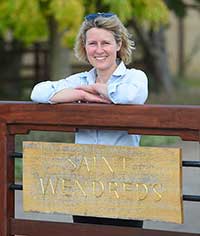
Newmarket racehorse trainer Ilka Gansera-Leveque will be adding a splash of colour to May’s Guineas weekend with an unusual art exhibition in her own Newmarket racing yard.
Ilka will be displaying work from 13 artists, including international names, alongside the thoroughbred racehorses in her Hamilton Road stables.
The ‘Art & Horse Racing’ exhibition will be open to the public free of charge at her picturesque Saint Wendred’s yard from 10am-6pm on Sunday May 7, 2023 - 1,000 Guineas Day.
It follows private viewings for racehorse owners, Vantage Point Racing Club members and invited guests during 2,000 Guineas Day on Saturday May 6, 2023.
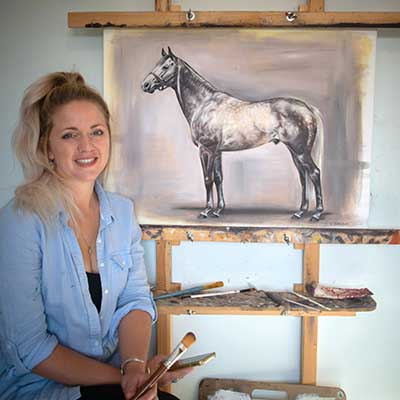
Emily Johnson, artist in residence at Cheltenham racecourse, is one of the exhibitors and can be seen painting during the exhibition – plus she is donating a sketch for visitors / social media followers to win.
Read more: Artists Will Add Splash of Colour to Newmarket’s Guineas Weekend
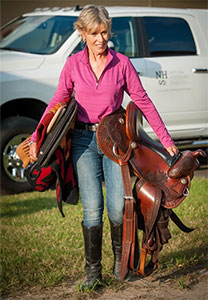
By Nick Pernokas
The third grader sat on her Grannie’s daybed, reading. Her grandmother’s cottage was in Old Saybrook, Connecticut, and the open window allowed in the ocean air and the sounds from an osprey nest in the tree outside. It was a Saturday and the girl and her sisters had just returned from Grannie’s weekly summer pilgrimage to the library. Now Letitia was engrossed in a world created by Walter Farley, in a book titled The Black Stallion.
“I remember thinking that I had to have horses in my life,” says Letitia Glenn, founding owner and saddle systems designer for Natural Horseman Saddles, as well as the newly christened company, Contour Saddlery.
Unfortunately, it would be many years before Letitia’s dream came true. At the age of 47, Letitia and her husband, Art Glenn, had become successful entrepreneurs. They had homes in Houston, and in Durango, Colorado. The Rocky Mountains called to them and they enjoyed the outdoor activities there, like skiing and back packing. Around 1990, they moved to Durango full time and purchased the O’Farrell Hat Company. Letitia felt that the time was right for a horse.
“I said, ‘Art, if I don’t have a horse before I die, I’m going to die!’” remembers Letitia.
Letitia had friends who were Paso Fino breeders and they gave her a well-bred two-year-old stallion. Her friends told her not to ride him until he was four. A corral was built in the backyard and Letitia began doing the groundwork on the colt. Within a year, Art became interested in horses as well and he purchased another Paso Fino for himself. When they were able to start riding the horses, the couple took them to a well-known saddletree maker to have their backs measured for custom trees.
Through Letitia’s involvement with the O’Farrell Hat Co., she met famed horse trainer Pat Parelli over the phone. Pat had called to order a custom beaver hat.
“He was absolutely lovely and didn’t request a discount, which impressed me.”
The Glenns, and hatmaker Kevin O’Farrell, soon took their hats to Germany for the Equitana trade show. Pat and Linda Parelli were also there conducting some horsemanship clinics. The couples became friends and eventually the Parellis stayed with the Glenns in Durango, while they searched for land in the area to build their first equine learning center. Letitia designed a logo for them and began to create custom clothing for the Parellis’ customers and fans. In 2000, Linda Parelli made a comment to Letitia that would alter her life.
“Linda said that saddles are all too often torture devices. “
Letitia thought to herself, “Luckily ours aren’t, because they were measured and built to fit our horses”.
Read more: Contour Saddlery: A New Way of Looking at an Old Art
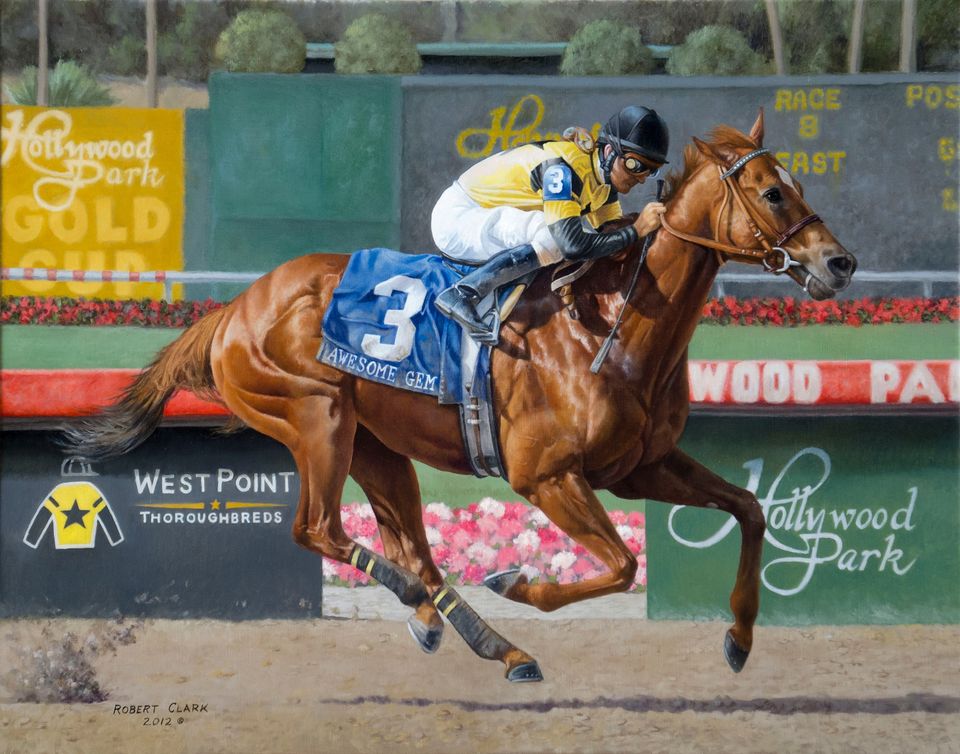
by Robert Clark
Gem has become a fan favorite. For many people it was because of his long tenure at the track where I believe he became the first million dollar earner for West Point Thoroughbreds. Before his career was through he would claim his Grade 1 victory in the Hollywood Gold Cup - as portrayed in this painting of him.
Many others have become a fan of Gem when he arrived at Old Friends in Kentucky (which is just a couple miles from my house now). There, Gem greets hundreds of fans on a regular basis.
But for me - Awesome Gem was a different kind of special and that was because a very dear friend in the sport Clyde Haugen loved this horse. I think Clyde had a piece of more than 20 different horses through West Point Thoroughbreds, but GEM was the ONE that made Clyde light up every time he talked about him. Clyde was one of the most inspiring guys you'd ever meet. He was a former fighter jet pilot and had transitioned to being a business mentor to groups of people all over the world. As much as he loved horse racing, Awesome Gem was the horse that Clyde would travel the world to watch run. Clyde even had a carousel horse made of Awesome Gem!
- Daring Your Horse to Be Good - a book excerpt from "The Horse Is My Teacher" by Van Hargis
- Thanks for Getting in Touch
- Must-read Websites and Blogs for Horse Lovers
- EIE at Equine Affaire 2022!
- Lost horse returns home after running with wild mustangs for 8 years in northern Utah
- Tribute To Queen Elizabeth II by Monty Roberts
- Queen Elizabeth II Honors 17 Trainers and Animal Advocates for Their Efforts to Reduce Violence in the Training of Horses
- The Best Horse-Related Games To Play On Your Computer
- Wise Dan: Hall of Famer Made by Love, Built for Speed
- How Horse-Crazy Was Born - an Excerpt from "A Man Walks Into a Barn"







